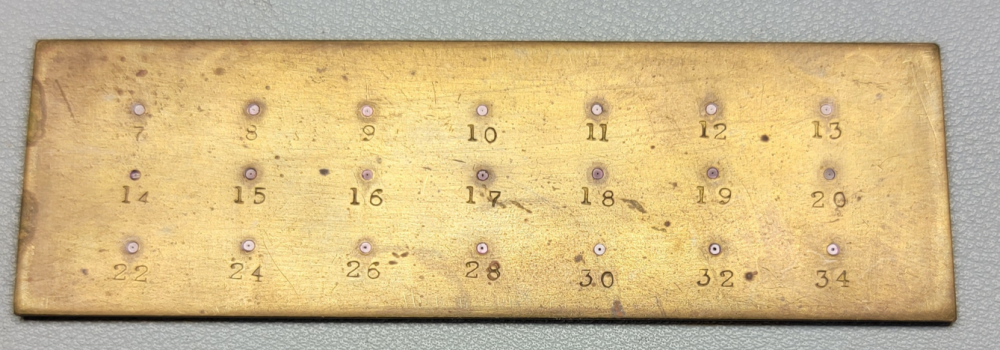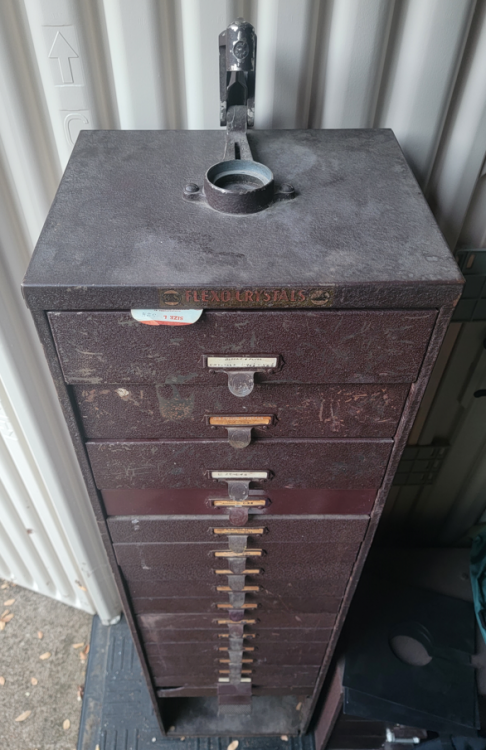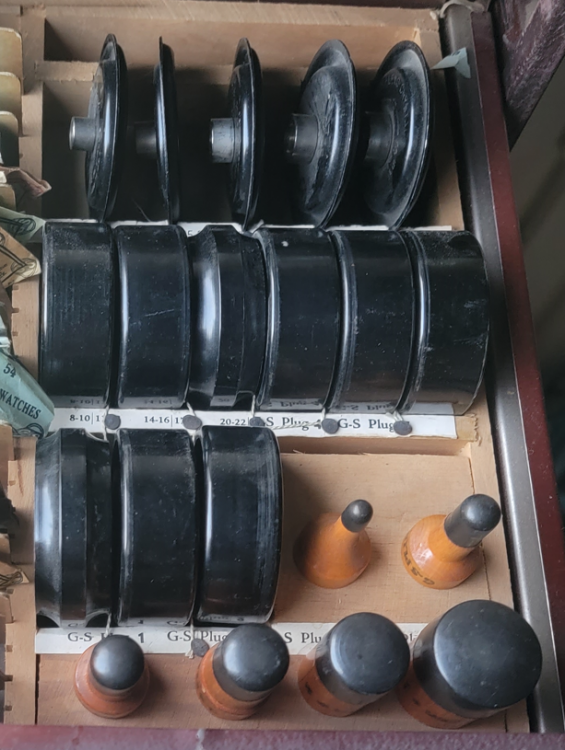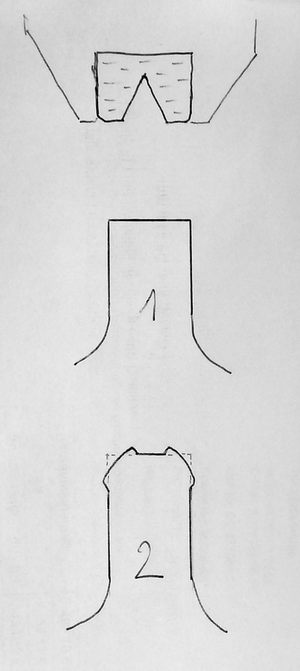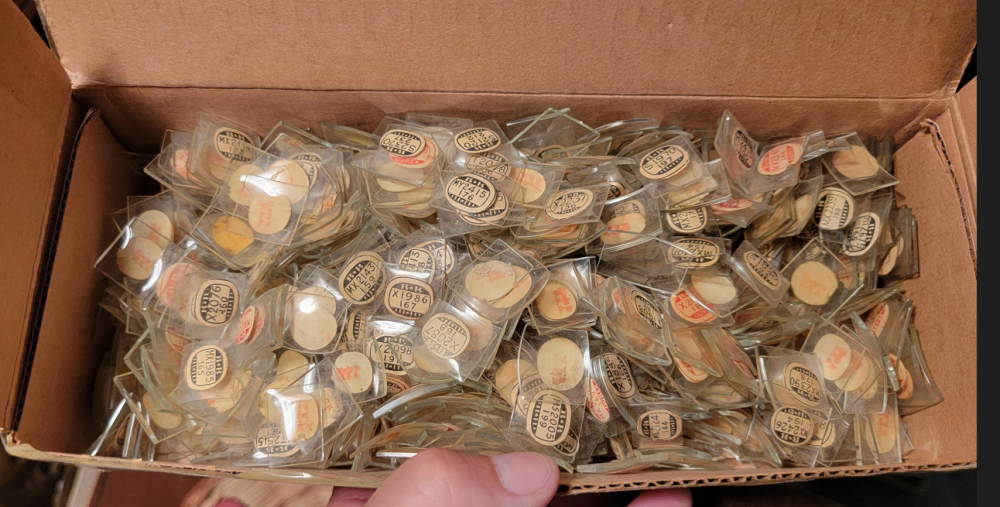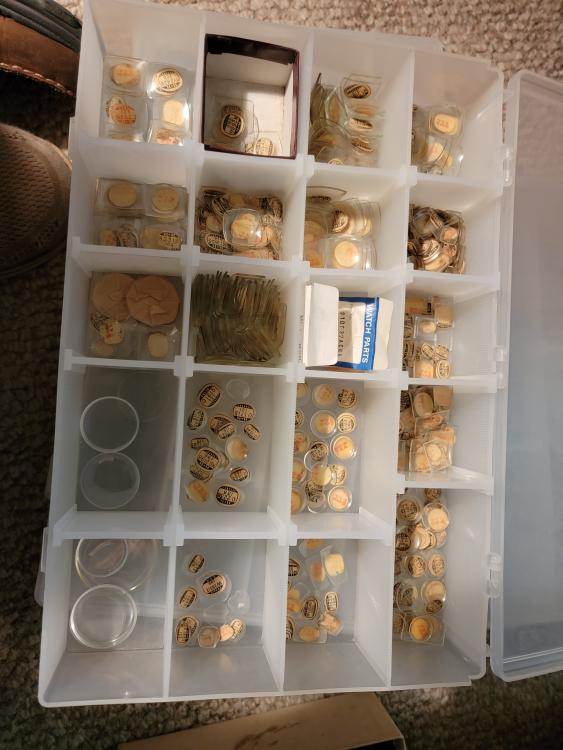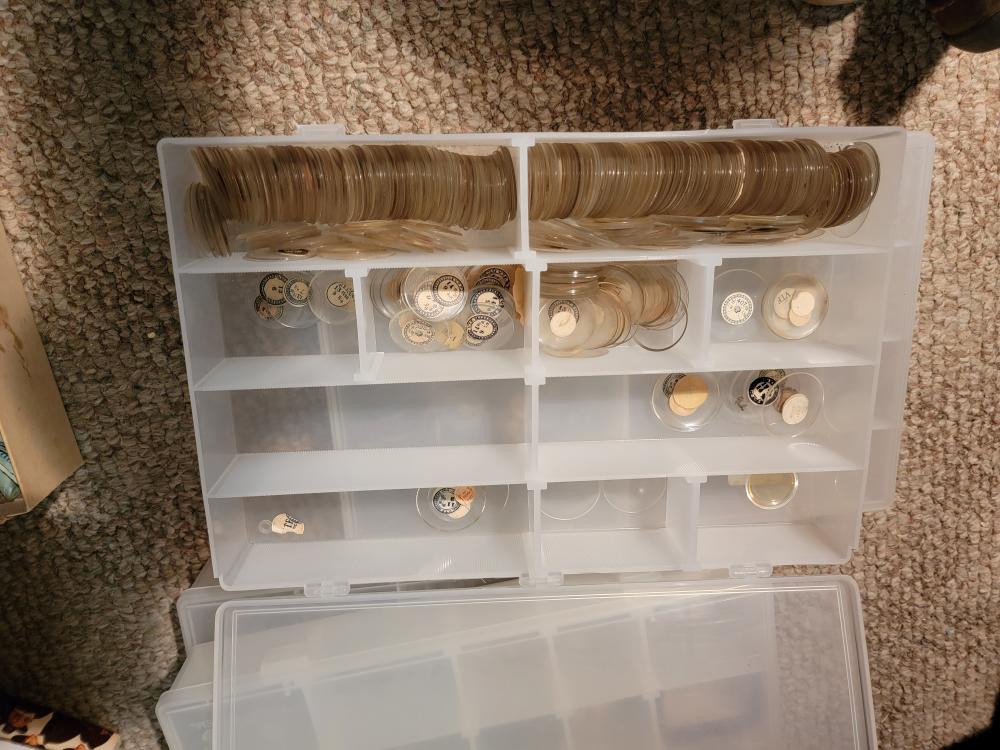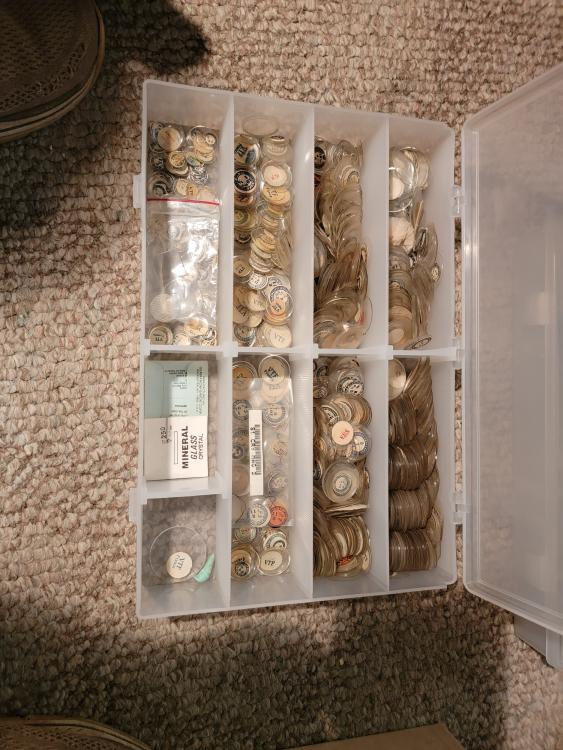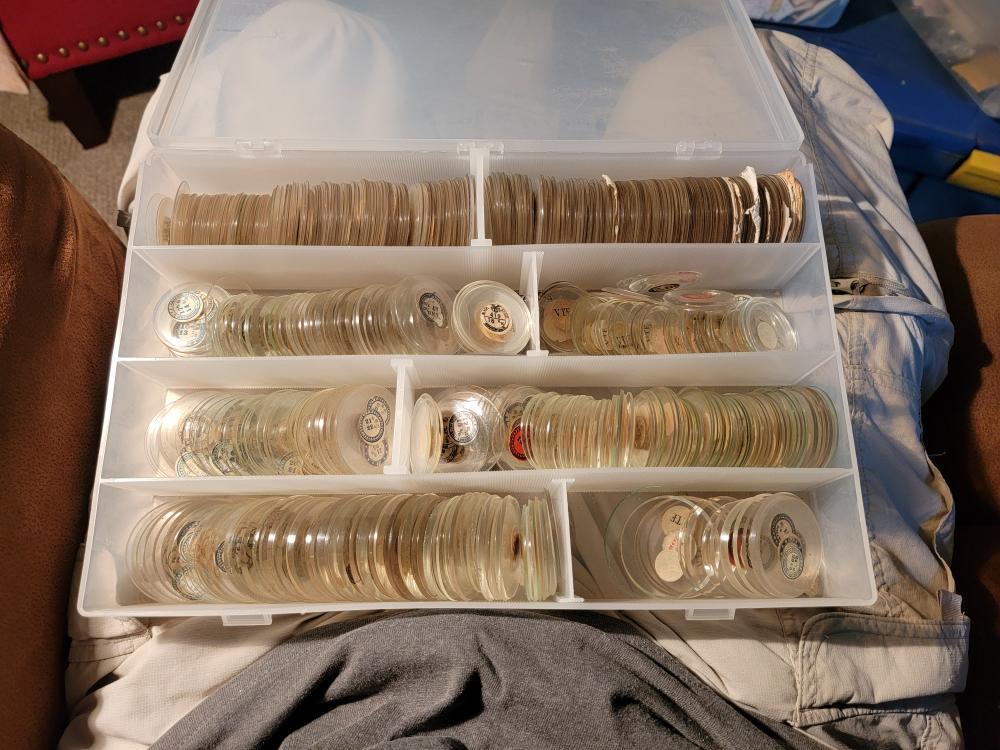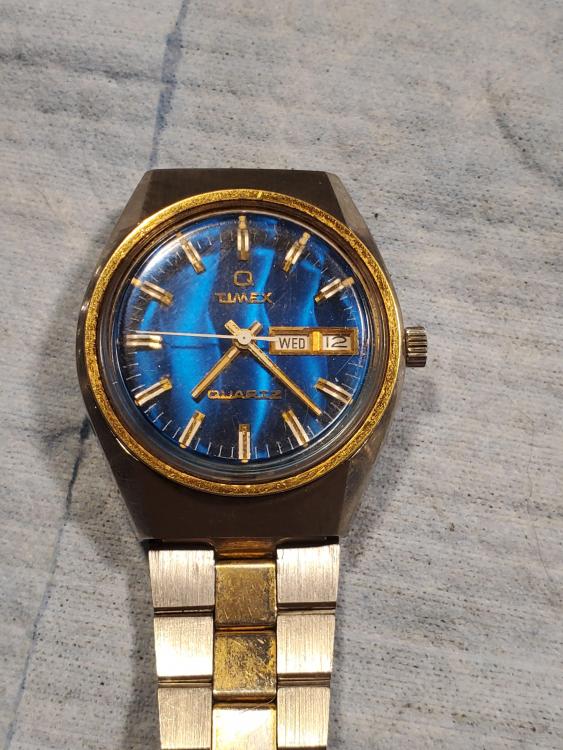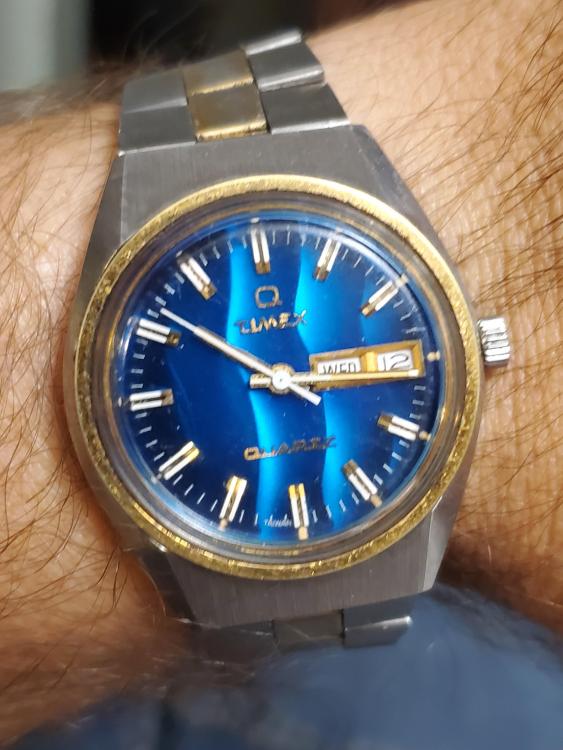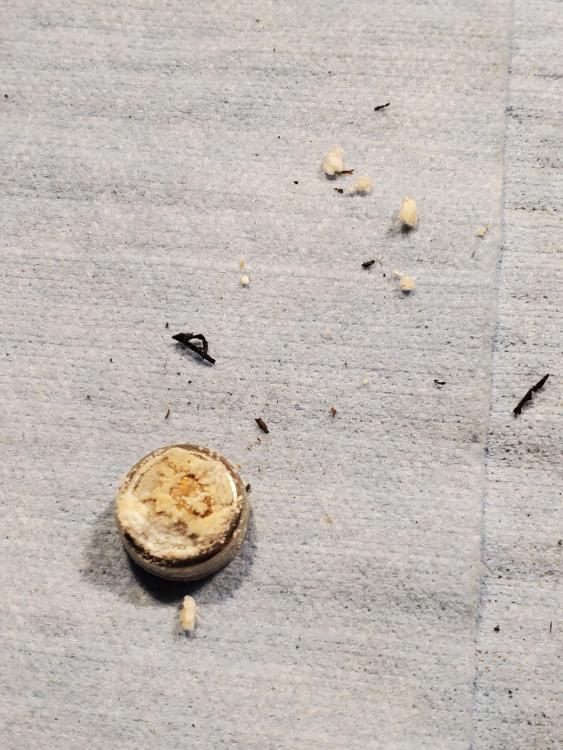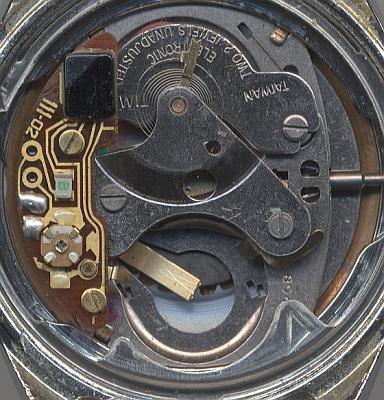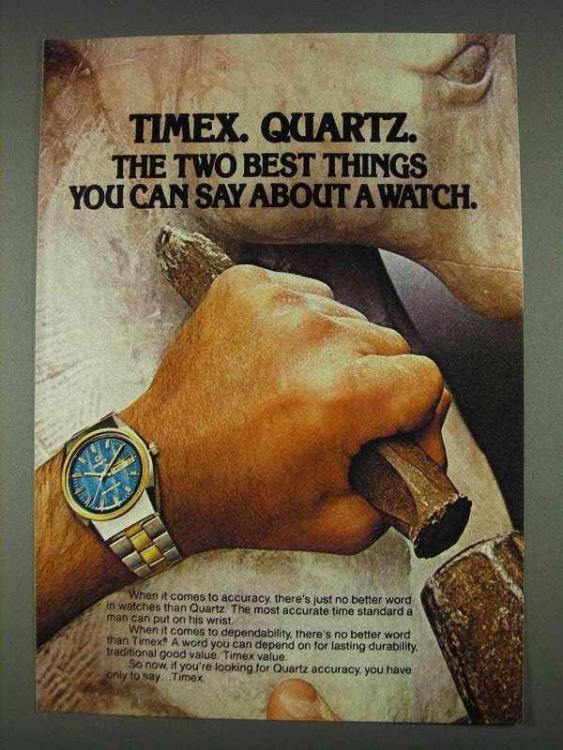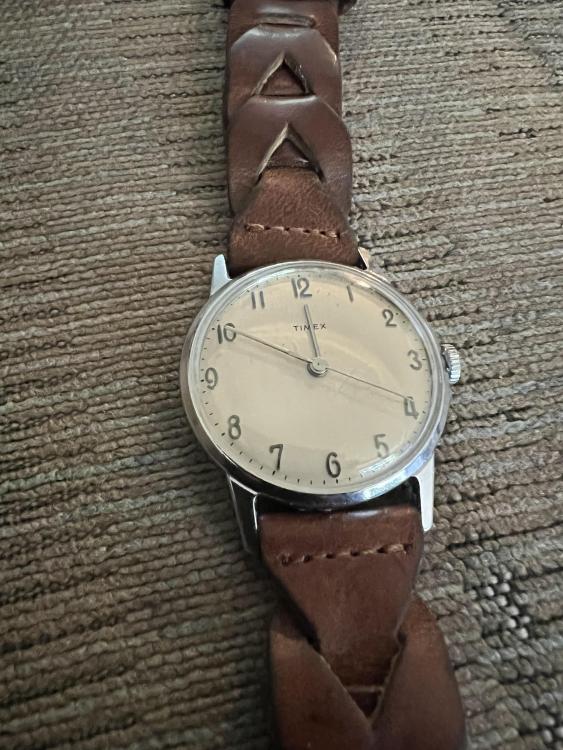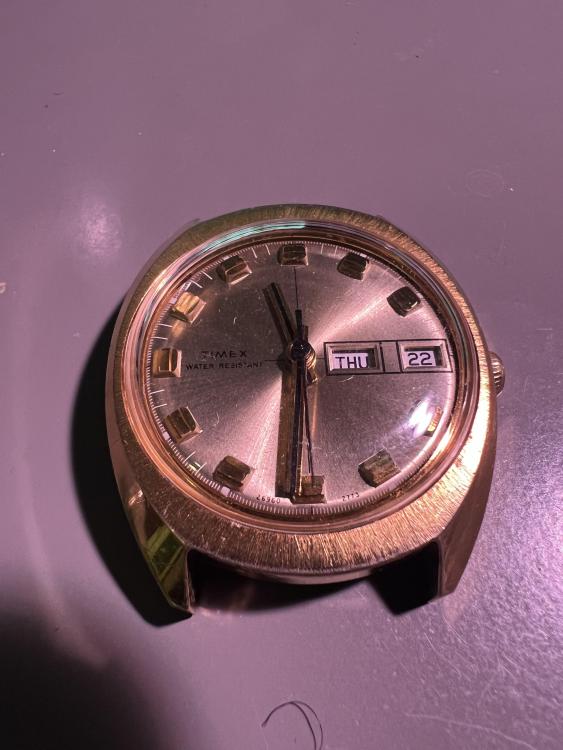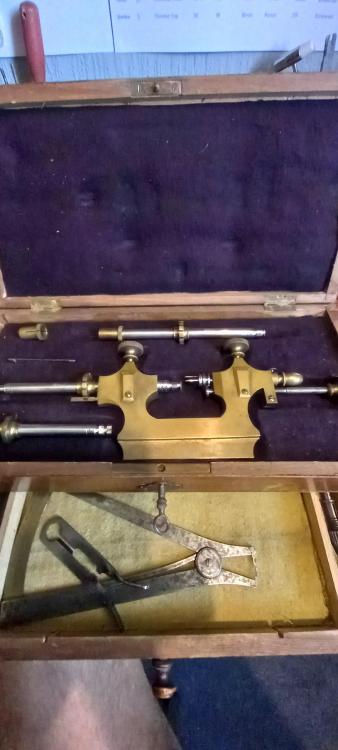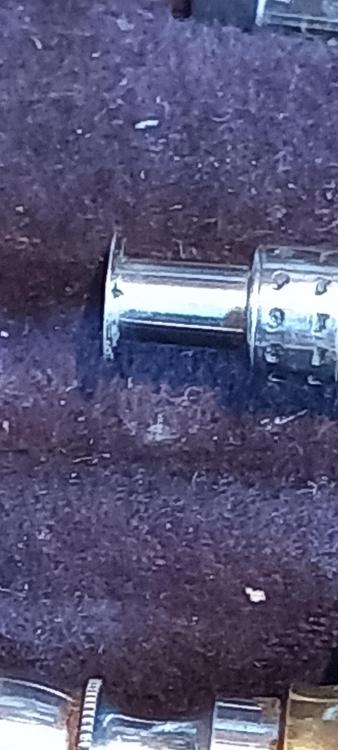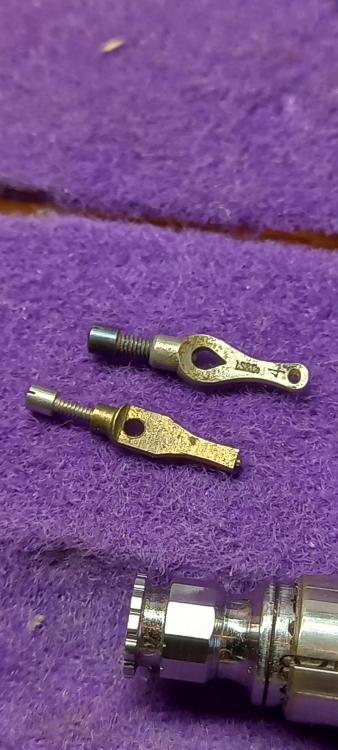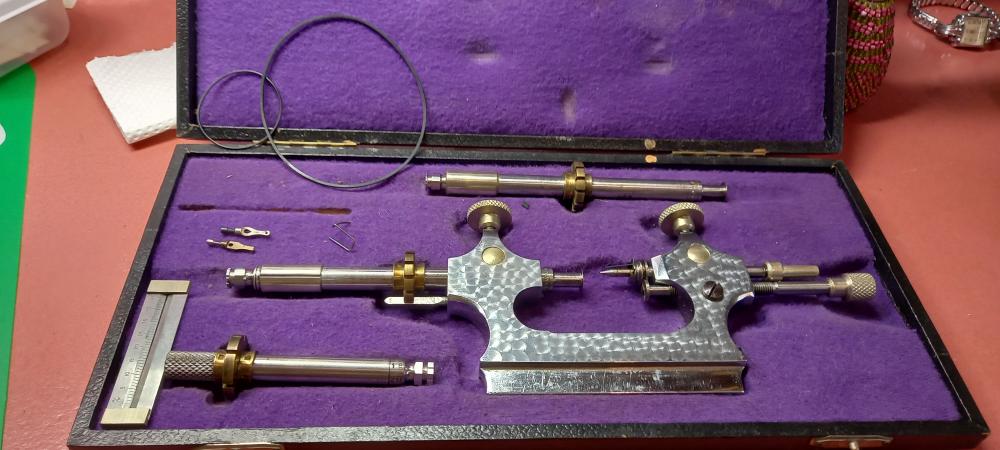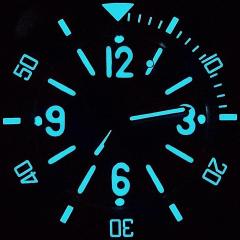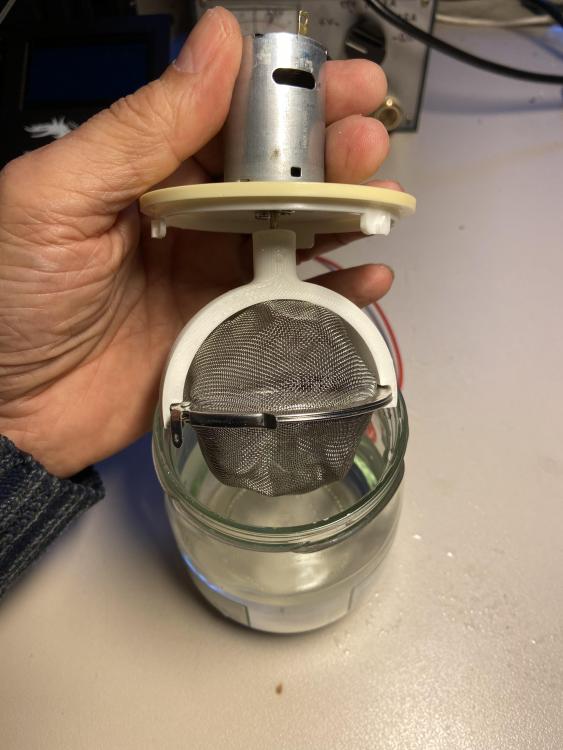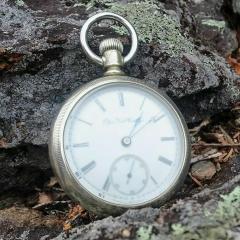Leaderboard
Popular Content
Showing content with the highest reputation on 09/23/22 in all areas
-
2 points
-
I picked this up on my trip to MN for my canoe trip. As noted in another thread, I also picked up some cleaning machines. This cabinet is full of crystals, all neatly organized. I was shocked with excitement to see that none of the inserts were missing. This is pretty unusual for something that is probably 60 years old. I will never use all of these crystals, but they are there...just in case! I also got a gillion class pocket watch crystals, and post about them at a later time.2 points
-
I had that tool, not Bergeon branded, for many years in my drawer. Never used it, never trusted it. The jewel in the tool looks like in my picture on top. Yesterday I made a test: flattened a pivot (1) then applied the tool like N described. Result was pivot (2): edges rounded, burrs produced! My suspicion was valid. Rounding is so easy and fast the traditional way: balance in the lathe or in the jacot like above and a "burnisher for rounding pivot-ends" (quote Bergeon). Frank2 points
-
As others have already stated, yes absolutely. It’s one of the primary functions of the Jacot tool which allows you to burnish a kind of polished hard skin onto the surface of the pivot after shaping which in turn makes the pivot more durable. The lantern is used for this purpose - if you have a dual purpose pivot file/burnisher you can shape and burnish within a few strokes. It’s doesn’t take much. By the way - anyone considering buying a Jacot set should look closely at the lantern or lanterns in the listing pictures before buying. They are often broke. A friend of mine had to buy (and send back) three sets before he actually found a good set. Some sellers attempt to hide the broken lantern in the listing images and if you’ve never used one before you might not realise until too late.2 points
-
2 points
-
No problem at all! We are all hear to learn, and I appreciate your comment. Wow this is great! Thank you so much for sharing, this is really helpful Great thank you, and yes it seems to be in good condition still.2 points
-
Introduction This service walkthrough is not a tutorial on how to service a watch movement. I made it for myself because I think it's fun and because it will make it easier the next time I service a Vostok 2431. I also think it feels nice to be able to share this walkthrough considering all the valuable information that many very talented members on WRT freely share. Many, many thanks! There is a lot to learn when servicing a watch movement that is not covered in this walkthrough. Therefore, I recommend, for example, watchfix.com, learnwatchmaking.com, or timezonewatchschool.com. I feel like I got the most bang for my buck at watchfix.com (I'm not sponsored in any way) but I've also had a lot of fun and benefited from the other online schools. Links to photos on my OneDrive Vostok calibre 2431 disassembly walkthrough. Please sort the images by name in ascending order. Vostok calibre 2431 assembly walkthrough. Please sort the images by name in ascending order. Curiosities I think it was in 2014 or possibly 2015 that I bought my Sturmanskie Open Space. I had just discovered that there were watches where the hour hand only rotates one revolution per day and at that time I knew absolutely nothing about watch movements, service and repair. The idea that the hour hand of a watch only rotates one revolution per day seemed not only completely logical but also different and fascinating. The earth rotates one revolution around its axis per day, so it should be obvious that the hour hands of our watches do so too. The fact that the letters on the watch were also Cyrillic did not make the whole thing any less exciting. I just couldn’t resist it and I’m happy I didn’t! Vostok claims that their movements only need a service every 10 years, and I think that's true because the tolerances are pretty rough and therefore large amounts of dirt are needed to stop a Russian movement or even cause it to run badly. It has been said that the amount of dirt required to stop a Vostok movement is enough to stop a hundred Patek Philippe movements However, the price for this endurance is a movement that doesn't come close to the precision offered by high-quality Swiss and Japanese movements, but it's still quite easy to get these Russian movements to run accurately as long as they're worn and used consistently. About the movement Russian watch brands such as Vostok, Raketa, and Poljot, to name a few, are known for using their in-house movements, but not this Sturmanskie which is instead powered by a Vostok calibre 2431, which is a 24-hour movement. However, it is not a true 24-hour movement. That is, the movement is not originally designed as a 24-hour movement. Instead, Vostok has modified the movement in its calibre 2416B so that the hour hand only rotates one revolution per day. Calibre 2431 is otherwise identical to Vostok automatic calibres 2416B and 2415. The motion work(/dial train) in Vostok 2431 The way that Vostok modified the movement so that the hour hand only rotates one revolution per day is by modifying a) the minute wheel, b) the bearing for the minute wheel in the main plate, and c), adding an intermediate date indicator wheel. The minute wheel has been modified so that it has two pinions that lie on top of each other. The lower pinion drives what I call the first intermediate date indicator wheel while the upper pinion drives the hour wheel and has been adjusted so that the hour wheel only rotates one revolution per day. The number of teeth on the hour wheel itself may have also been adapted, but this is not something that I have investigated. Normally the minute wheel is mounted on a regular metal post on the main plate, but in this case, Vostok has replaced the post with a beefy, jewelled bearing. I assume that this has been necessary to get the minute wheel, with its two pinions on top of each other, to rotate sufficiently smoothly and stably. The added first intermediate date indicator wheel drives the second intermediate date indicator wheel which is part of Vostok's regular (non-modified) calendar complication. And this is what it looks like with the hour wheel mounted. Cleaning I have found that it is all too easy to underestimate the importance of cleanliness when servicing a movement, perhaps because the parts are microscopic and therefore it takes time to get used to thinking microscopically, even though I have been doing this now for five years. Cleaning of pinions and pivots A type of watch movement part that is particularly important but also difficult to get completely clean is pinions, but @nickelsilver advised me quite recently that in its pre-cleaning you can dip and rub the pinions in pith wood that you have impregnated with an effective degreasing agent, for example, Horosolv. I've done it several times now and it works amazingly well. Speaking of pinions, independent American watchmaker Josh Shapiro mentioned in a podcast that he considered pinions to be the most difficult part of a watch movement to make perfectly. Whether it's true or not I don't know but I think it's likely. To get the pivots clinically clean, I have also started using EVEFLEX, but you have to be careful because the material has an abrasive effect. It is important to choose the right polisher and to be careful. I have summarized my experiences with EVEFLEX in this post and I mention it because EVEFLEX is easy and quick to work with and gives me very good results. End-shake If there's one thing I've learned this time around, it is that a Russian movement cannot be converted to a Swiss movement because the tolerances in Russian movements are generally much coarser. Experimentally, I adjusted the end-shake to 2/100mm on everything from the pallet fork to the centre wheel, with the result that the amplitude and rate became extremely erratic. I created a thread about this: "Can end-shake and or side-shake ever be too small?" As you will see if you follow the thread, once again @nickelsilver, @Shane, and @JohnR725came to my rescue. Many thanks! My recommendation is to let the end-shake be slightly wider on Russian movements. After I increased the end-shake to approx. 4/100 mm, the amplitude and rate returned to typical, i.e., still somewhat irregular but perfectly normal for a Russian movement. Side-shake In this video, Kalle Slaap from Chronoglide shows an amazingly simple and effective way to determine if the side shake is correct. Since there was a crack in the third wheel jewel in the train wheel bridge, I replaced it, and when I then used Kalle Slaap's method, I could clearly see the 3rd wheel pivot jumping back and forth in the jewel hole. So, I replaced the jewel with a hole that was 1/100mm smaller and the visual difference, just changing it by 1/100 mm, was nothing less than dramatic. I am incredibly happy that I got to learn this simple and exceptionally clear method. Many thanks to Kalle Slaap at Chronoglide! Vostok reverser wheels If you Google “Vostok reverser wheels”, there is a lot of whining going on. I don't think there are any major problems with Vostok's reverser wheels, but they are unfortunately easy to damage during service or modification of the movement, and I think that is the real reason for the whining. Next to Seiko watches, Vostok watches are immensely popular to modify in terms of dials and hands, and in addition, many people want to fix the seconds hand that sometimes stutters on these movements. The latter is done by bending the second-hand pinion spring illustrated in this thread. To make these modifications, the oscillating weight/rotor must be removed and when it is to be screwed back on, it is easy for the rotor pinion to end up on top of the teeth of the reverser wheels. If you tighten the rotor screw in that position, even just a little, the reverser wheels will inevitably be damaged. The result is that the automatic winding stops working or only works intermittently. An easy way to check if the reverser wheels are working as they should is to manually rotate the oscillating weight alternately about 20 degrees in both directions with a piece of peg wood while looking at the 1st reduction wheel which is large and easy to see. If the 1st reduction wheel continuously rotates in the same direction (counterclockwise, if I remember correctly), no matter which way you rotate the oscillating weight, you can be sure that the reverser wheels are working as they should. If, on the other hand, the 1st reduction wheel rotates alternately in both directions when you rotate the oscillating weight alternately, then you can be sure that the reverser wheels are damaged and need to be replaced. Servicing the automatic mainspring I find it difficult to service the mainspring on automatic movements. It is, in my opinion, a construction that leaves room for improvement and that is why I generally prefer manually wound movements. If the mainspring in an automatic movement slips too soon, it reduces the amplitude and the power reserve, and if the mainspring slips too late, there is the risk of re-banking and that the movement runs much too fast when you are physically active, especially when you take a brisk walk swinging your arms, and the oscillating weight rotates constantly. The effect is like continuously turning the crown of a manual movement with high pressure when the mainspring is already fully wound. Not good! What I learned this time anyway, long story short is that you can be quite generous with braking grease on the rim on the inside of the mainspring barrel. Even if some of the braking grease ends up where it really shouldn't be, I don't think it will destroy or affect anything negatively. Also, and again from Kalle Slaap at Chronoglide, I learned that you should press at the end of the spring at the bridle when it is mounted in a spacer, and you are about to push it into the mainspring barrel. In this way, the rest of the spring automatically follows down into the mainspring barrel. You can see it in this clip. Very smooth, especially in combination with my highly rated Master Craft mainspring winder which I wrote about in this post. Lubrication of cap jewels For a long time, I have had trouble getting the oil to stay in the centre of the cap jewels and not flow out after I oiled them and installed them, despite treating them with epilame (Fixodrop). I think it's because (and now I'm going by gut feeling) that I previously always installed the shock assembly in the main plate before installing the balance and that I didn't treat the jewel housing (chaton) with epilame. After several failures in servicing this movement, I decided to treat both the cap jewels and jewel housings with epilame and mount the shock assembly after having replaced the balance. It did the trick and also made fitting the three-legged anti-shock spring much easier. My theory is that the balance staff pivots stabilize the oil in the centre of the cap jewels when the jewel housing (chaton) is dropped into place, and better hold the jewel housing in place, which will otherwise slide around while installing the three-legged anti-shock springs. Have I just written the longest post in the history of WRT? Anyway, hope you enjoyed it!1 point
-
Just received my original 1978 Timex Falcon Eye. This blue dial is hypnotic. The battery had indeed leaked, but the corrosion was confined to the battery itself. I carefully removed the battery and cleaned the muck left behind. I carefully brushed out the rest of the crumbs and the dial with a clean dry paint brush. Absolutely nothing was corroded other than the battery itself. I popped a fresh battery in, gave it a wiggle and the balance took off running. It's been running since and keeping great time. The movement, I believe, is a M63 quartz regulated electro-mechanical model. I'll polish the crystal next week and clean up the rest. Considering how pricey the vintage models are going for, I did pretty food on this one, less than $30. Miraculously, the band fits PERFECTLY! I guess now that I own one, Timex says it can help me to carve stone horses, SWEET! Just what I always wanted!1 point
-
Evaporust is good but can turn things black if left soaking for too long. Will have to try the Ultrasonic method next time, with both Evaporust and White Vinegar, as both normally need a good 24 hours soak to work. I mainly use it to renovate rusty tools though as I have found watch parts tend to just dissolve when left too long soaking and I am good at forgetting things1 point
-
1 point
-
Hello folks! Attached are a few of my recent repairs / TLC projects. Working on a vintage Q Series now. Trying to figure out how to get it moving. Have a great weekend. 1967 Timex Marlin. Movement bath, light lubrication, cleaned dial with Distilled water, polished crystal with Toothpaste then PolyWatch. Leather strap from my recycle bag. I believe the other is a 1974 Sportster? Just needed a good cleaning. Arrived in great working condition. Ultrasonic cleaned bracelet and applied new acrylic crystal.1 point
-
Thanks HectorLooi , I've seen them in job lot sales, nice extra little bonus with my purchase. Absolutely dont get duped. The first one i bought did have damage on the smallest pivot lantern which is understandable with it being the most used. I did know as i asked to see the ends so the seller reduced the price by quite a lot, that I couldnt turn down plus it had other goodies with it. The second one is absolutely perfect and was actually cheaper than the first by a few quid. Looking forward to using it as soon as i find a burnishing tool. I was thinking of just making something from some tool steel, possible a hardened blade of some description. How would the v shaped jewel ever produce anything but no. 2. ?1 point
-
This is not a money-making operation. If you cannot find a crystal you need...and I have it...I will be happy to send it to you.1 point
-
Oooooo!!!!!! So the long end goes between the forked fingers of the pulley? For, like, turning shafts that don't have a spoked wheel attached? I need some of those! Or I need to MAKE some of those! Thank you @HectorLooifor explaining!1 point
-
Those are lathe dogs. They are used to transmit motion to a piece of work being turned between centres.1 point
-
1 point
-
Yes mate. Ive seen it on you tube and read it in books as well. The opposite side of the jacot lantern to the burnishing end that reduces the pivot diameter. I'm same as you, received a jacot last week along with a load of extras I'll post it up later to get your opinion. l also have another one different make coming soon as well as a repivoting tool.1 point
-
I don't know if it's the same seller on Etsy that I used. I hope not. That guy kept telling me he was going to send me videos to fix my problem, which honestly seemed nonsensical considering that my problem was the unit wouldn't power on, but he never sent me any videos anyway. In fact the last message I sent to him 2 months ago was, "where are the videos you told me you were going to send me". He has yet to reply.1 point
-
It seems like we have enough tinkerers on here to get our machines running well. The Etsy seller got back to me and said, " You need to fix the basket arrow mark to machine arrow mark I will share videos too how to fix it" I'm a bit skeptical that anything short of some new parts will fix it, but we'll see if this guy can come thru. I'll update when those videos come thru.1 point
-
Hi muddtt, those are the stars that go in the bottom I don't know which ones are better but the stars can't hit the basket like the ones I have. See how smooth his L&R is! ..... nice I wish ours did Fow&Rev that would be nice as well.1 point
-
I asked the owner of my Dad's former shop if they still have the cabinets. He sent me a picture--yes. I asked if they ever use the press. He said, yes, a couple of times a month. At some point, I need to stop acquiring stuff, but for now, it is still fun.1 point
-
Hello and welcome to the forum. If a watch suffers battery leakage it quite often destroys the watch cct I think Hectors advice is the way to go and find a working donor.1 point
-
1 point
-
Welcome to WRT @MJR123 I look on eBay for Seiko H601-5479 and found many for sale or auction. Your best bet would be to get a working donor watch and transplant the movement into your watch. Since the watch is of sentimental value, it's best to practice on some scrap watches first before attempting the actual transplant. Good luck and don't be afraid to ask questions.1 point
-
If it's the centre wheel, I'd put a tiny amount of D5 or HP1300 on the shoulder of the centre wheel pivot, not on the jewel itself as any excess might flow into the tube of the centre wheel and get onto the centre seconds arbor.1 point
-
I think if the setting is unscrewed and removed there will be 2 jewels there. One in the setting and one in the bridge. Both have holes. The jewel in the setting that is screwed on top will be for the 4th wheel (sweep seconds) and the jewel with larger hole in the bridge for the center wheel. Both jewels would be oiled. The center wheel would have a tube for a pivot and is installed under the bridge in the photo. Remove the setting to confirm, then clean the jewels well. It would be removed anyway to adequately clean.1 point
-
Hi To test the rotation remove basket and the impeller, now you have the bare motor shaft. Spin up the motor and check the shaft for any deviation. If the shaft is ok then fit the impeller and repeat the test and watch the assembly for being true, and then fit the basket and repeat the test again. To tighten the clamp take out the brass key and substitute it with a hard wood one and tighten down the clamp. As you tighten down the wood will compress a little and grip the shaft. It mat be that the brass key is too thick and not allowing the clamp to grip properly. Just a few Ideas to consider. cheers1 point
-
@VWatchiethis was a very nice write up and was thoroughly illustrated. Thanks for the mention by the way. I had read through this shortly after it was posted and responded with a like but have been very busy here getting ready for winter, as well as several extra work related responsibilities. Your mentioning a watches rate increase with vigorous activity from this thread, as well as another one you also authored may need some further discussion. I didn't want to reply without giving it some consideration but all I can come up with is either, Incompatible breaking grease. A grease that is only as slippery as is mechanically necessary. This has always sounded like Voodoo to me. I have recently purchased some 8217 grease recently recommend by Mark. Incorrect mainspring (applying to much force against the inside of the barrel). Possibly intended for a barrel of a larger diameter. I would think that either way, for whatever reason, the two situations should be observable on the beach. The idea about the hairspring sticking may be harder to verify without the dynamics previously mentioned. Have you had time to look into this? PS, I have also just recently looked at several Vostok watches. Shane1 point



